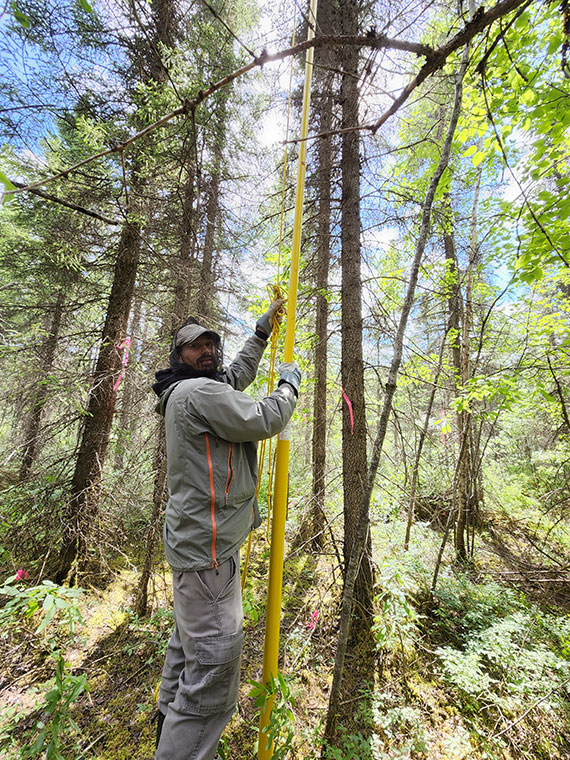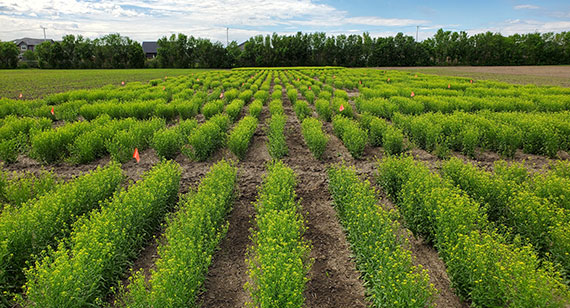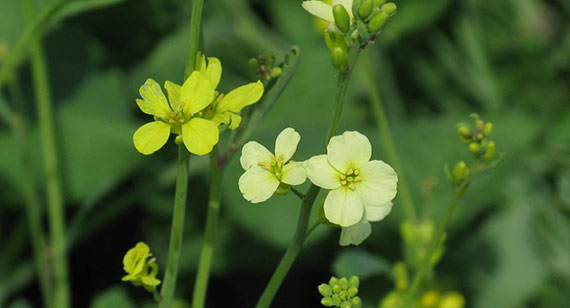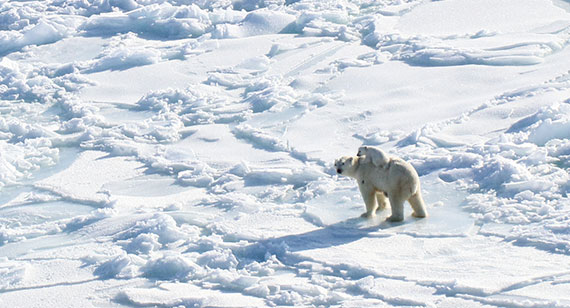Funding period: 2022–2027
Leads: James Macklin, Agriculture and Agri-Food Canada, and Ian Bradbury, Fisheries and Oceans Canada
Total GRDI funding: $9,480,000
Globally, climate change is severely impacting the environment. In Canada, the climate continues to warm at more than double the global rate, with Northern Canada expected to experience the most extreme changes.
There is a growing need for science advice on how key species are expected to respond to climate change, and the related economic and societal implications. Genomics offer a powerful set of tools that can rapidly assess biodiversity and ecosystem health, and help scientists predict how species and ecosystems will respond to climate change.
Will Canadian species be able to adapt to climate change? (Transcript)
Over 60 Government of Canada scientists and their teams are collaborating on the genomic adaptation and resilience to climate change (GenARCC) project. Using genomic tools, the GenARCC team aims to inform climate change adaptation to protect Canada's biodiversity, ecosystem resiliency, food security and human health. The GenARCC team is using its expertise to address 3 questions across forest, tundra, agricultural, aquatic and coastal ecosystems:
- How are critical species and populations genetically adapted to their environment?
- Is this relationship changing in response to climate change?
- How will these critical species and populations respond in the coming years?
Highlights
- 5-year collaboration
- 63 scientists and their teams
- 8 federal departments and agencies
Objective
To use genomics to assess the vulnerability of species to climate change for the protection of Canada's biodiversity, ecosystem resiliency, food security and health
Envisioned Benefits
- Genomic data and resources generated to support ongoing research and capacity building
- Genomic tools developed to monitor impacts of land use and climate change on the surrounding ecosystems
- Science advice to inform climate-resilient management and conservation, as well as related economic and societal implication
- Tools to improve science literacy related to genomics and climate change
Areas of focus
Forest and tundra ecosystems
Forests and tundra are essential spaces for people in Canada, providing ecosystem services, social and cultural benefits and economic value. These ecosystems clean the air and water, regulate and cool climate, and mitigate floods and soil erosion. They also provide critical habitat for many plants and animals and are a vital part of the Earth's carbon cycle. However, because of global climate change, the health and productivity of Canadian forests and tundra are declining.
Some impacts of climate change:
- Higher risk of drought and forest fire due to increased temperatures and unpredictable levels of precipitation
- Increased susceptibility to existing pests and pathogens as trees become physiologically stressed
- Introduction of novel threats as the distribution of species shifts
- Changes to ecosystem services, such as carbon storage, due to shifts in the biodiversity and function of microbiomes
GenARCC forest and tundra research activities investigate the complex and interconnected response of these ecosystems to climate change. Researchers are looking at individual species as well as the diversity of whole communities to develop a holistic understanding of adaptation and vulnerability to climate change and threats in these ecosystems. Researchers are combining genomic data with integrated ecological monitoring and machine learning to determine the adaptive capacity of key tree and wildlife species, along with their associated microbes. This information will help researchers predict how forest and tundra species will respond to climate change and improve climate-resilient management practices.

Photo credit: Benjamin Marquis

Photo credit: Benjamin Marquis
Agro-ecosystems
Across Canada, over 60 million hectares of land are used for primary agriculture, contributing to our economy,providing essentialresources and ensuring food security.
Some impacts of climate change:
- Physiological stress due to higher temperatures
- Increased invasive insects, plants and pathogens
- Declining populations of beneficial insects, such as pollinators
- Potential for new agricultural opportunities
GenARCC agro-ecosystem research activities are combining genomics, artificial intelligence and machine learning to address the complex impacts of climate change on these ecosystems. Researchers are studying species that are vital to the health and productivity of Canada's agricultural sector, including oilseed crops, bison, insects and invasive plants, as well as associated microbiomes and their roles. In addition, researchers are developing sensor technology for in-field analysis to provide real-time characterization of plant nutrients and traits. Together, these research activities will assess the genomic vulnerability and adaptive capacity of species central to Canada's agricultural sustainability and result in genomic tools to monitor the diversity, health and impacts of climate change on these species.

Photo credit: Christina Eynck

Photo credit: Muhammad Anzar

Photo credit: Christina Eynck
Aquatic and coastal ecosystems
Canada has the longest coastline of any country and over 2 million lakes and rivers, making aquatic and coastal ecosystems essential for Canada's biodiversity, economy and cultural identity.
Some impacts of climate change:
- Physiological stress due to changing environmental conditions, such as higher temperatures and increased ocean acidity
- Competitive interactions and the spread of pathogens as the distribution of species shifts
- Altered food webs due to changes in species diversity and abundance
GenARCC aquatic and coastal research activities are using genomics with machine learning and climate modelling to address the complex impacts of climate change on both aquatic and terrestrial species in these ecosystems. Researchers are assessing the genomic diversity and adaptive capacity of fish and wildlife species important to Indigenous communities and to Canada's fisheries. They are also developing genomic tools to monitor the diversity and health of salmonid species in freshwater ecosystems to look at how food webs are being affected by climate change. Research activities include using modelling approaches to evaluate potential climate-related threats from emerging pathogens such as viruses, parasites and bacteria, with an emphasis on both human and wildlife health. Understanding the vulnerability and adaptive potential of aquatic and coastal species is an important first step in developing effective strategies to ensure the conservation of biodiversity in the face of climate change.

Photo credit: Bronwyn Harkness

Photo credit: David McGeachy
Funded participants
- Agriculture and Agri-Food Canada
- Canadian Food Inspection Agency
- Department of Fisheries and Oceans
- Environment and Climate Change Canada
- Health Canada
- National Research Council of Canada
- Natural Resources Canada
- Public Health Agency of Canada
Collaborators
- Aklavik Hunters and Trappers Committee
- Blood Tribe – Kainaiwa
- Canadian Rivers Institute
- Canadian Wildlife Federation
- Carleton University
- Dalhousie University
- Ehdiitat Renewable Resources Council
- Fisheries Joint Management Committee
- Global Institute for Food Security
- Gwich'in Renewable Resources Board
- IAMGOLD Westwood Gold Mine
- McGill University
- Nunavik Research Centre
- Nunavut Arctic College
- Olokhaktomiut Hunters and Trappers Committee
- Ontario Ministry of Natural Resources and Forestry
- Parks Canada
- Paulatuk Char Working Group
- Paulatuk Hunters and Trappers Committee
- Queen's University
- Rat River Working Group
- Tetlit Renewable Resources Board
- Trent University
- Ulukhaktok Char Working Group
- Université du Québec à Trois-Rivières
- Université du Québec en Abitibi-Témiscamingue
- Université Laval
- Université TÉLUQ (in French)
- University of Alberta
- University of Guelph
- Lancaster University
- University of Manitoba
- University of North Texas
- University of Ottawa
- University of Saskatchewan
- U.S. Department of Agriculture's Agricultural Research Service
- Veterinary Agri-Health Services Ltd.
- West Side Working Group
Publications
- Ahmed R, Nasheri N. 2023. Animal reservoirs for hepatitis E virus within the Paslahepevirus genus. Veterinary Microbiology. Vet Microbiol 278:109618. https://doi.org/10.1016/j.vetmic.2022.109618
- Alkie TN, Lopes S, Hisanaga T, Xu W, Suderman M, Koziuk J, Fisher M, Redford T, Lung O, Joseph T, Himsworth CG, Brown IH, Bowes V, Lewis NS, Berhane Y. 2022. A threat from both sides: Multiple Introductions of genetically distinct H5 HPAI viruses into Canada via both East Asia-Australasia/Pacific and Atlantic flyways. Virus Evolution 8(2). https://doi.org/10.1093/ve/veac077
- Alkie TN, Cox S, Embury-Hyatt C, Stevens B, Pople N, Pybu MJs, Xu W, Hisanaga T, Suderman M, Koziuk J, Kruczkiewicz P, Nguyen HH, Fisher M, Lung O, Erdelyan CNG, Hochman O, Ojkic D, Yason C, Bravo-Araya M, Bourque L, Bollinger TK, Soos C, Giacinti J, Provencher J, Ogilvie S, Clark A, MacPhee R, Parsons GJ, Eaglesome H, Gilbert S, Saboraki K, Davis R, Jerao A, Ginn M, Jones MEB, Berhane Y. 2023. Characterization of neurotropic HPAI H5N1 viruses with novel genome constellations and mammalian adaptive mutations in free-living mesocarnivores in Canada. Emerging Microbes & Infections. Emerging Microbes and Infections 12(1):2186608. https://doi.org/10.1080/22221751.2023.2186608
- Auer L, Buée M, Fauchery L, Lombard V, Barry KW, Clum A, Copeland A, Daum C, Foster B, LaButti K, Singan V, Yoshinaga Y, Martineau C, Alfaro M, Castillo FJ, Bosco Imbert J, Ramírez L, Castanera R, Pisabarro AG, Finlay R, Lindahl B, Olson A, Séguin A, Kohler A, Henrissat B, Grigoriev IV, Martin FM. 2023. Metatranscriptomics sheds light on the links between the functional traits of fungal guilds and ecological processes in forest soil ecosystems. New Phytologist. https://doi.org/10.1111/nph.19471
- Berhane Y, Joseph T, Lung O, Embury-Hyatt C, Xu W, Cottrell P, Raverty S. 2022. Isolation and Characterization of Novel Reassortant Influenza A(H10N7) Virus in a Harbor Seal, British Columbia, Canada. Infectious Diseases 28(7):1480-1484. https://doi.org/10.3201/eid2807.212302
- Birchard K, Driver HG, Ademidun D. et al. 2023. Circadian gene variation in relation to breeding season and latitude in allochronic populations of two pelagic seabird species complexes. Sci Rep 13, 13692. https://doi.org/10.1038/s41598-023-40702-8
- Caliendo V, Lewis NS, Pohlmann A, Baillie SR, Banyard AC, Beer M, Brown IH, Fouchier RAM, Hansen RDE, Lameris TK, Lang AS, Laurendeau S, Lung O, Robertson G, van der Jeugd H, Alkie TN, Thorup K, van Toor ML, Waldenström J, Yason C, Kuiken T, Berhane Y. 2022. Transatlantic spread of highly pathogenic avian influenza H5N1 by wild birds from Europe to North America in 2021. Scientific Reports 12(1):11729. https://doi.org/10.1038/s41598-022-13447-z
- Crowley SE, Bentzen P, Kess T, Duffy SJ, Messmer AM, Watson B, Dempson JB, Keefe DG, Perry RC, Marquis B, Hajibabaei M, Fahner N, Berghuis L, Hobrecker K, Bradbury IR. 2024. eDNA metabarcoding reveals riverine fish community structure and climate associations in northeastern Canada. Environmental DNA, 6, e517. https://doi.org/10.1002/edn3.517
- Depardieu C, Lenz P, Marion J; Nadeau S, Girardin M, Marchand W, Bégin C, Treydte K, Gessler A, Bousquet J, Savard M, Isabel N. 2024. Contrasting physiological strategies explain heterogeneous responses to severe drought conditions within local populations of a widespread conifer. The Science of the Total Environment 923(11): 171174 https://doi.org/10.1016/j.scitotenv.2024.171174
- Fisher M, Nebroski M, Davies J, Janzen E, Sullivan D, Lung O. 2023. Discovery and comparative genomic analysis of a novel equine anellovirus, representing the first complete Mutorquevirus genome. Scientific Reports 13(3703):1-10. https://doi.org/10.1038/s41598-023-30875-7
- Harkness BAS, Ibarguchi G, Poland VF, Friesen VL. 2024. Historical fragmentation and stepping-stone gene flow led to population genetic differentiation in a coastal seabird. Ecology and Evolution, 14, e11204. https://doi.org/10.1002/ece3.11204
- Jeffery NW, Vercaemer B, Stanley RRE, Kess T, Dufresne F, Noisette F, O'Connor MI, Wong MC. 2024. Variation in genomic vulnerability to climate change across temperate populations of eelgrass (Zostera marina). Evolutionary Applications, 17, e13671. https://doi.org/10.1111/eva.13671
- Kess T, Lehnert SJ, Bentzen P, Duffy S, Messmer A, Dempson JB, Newport J, Whidden C, Robertson MJ, Chaput G, Breau C, April J, Gillis C-A, Kent M, Nugent CM, Bradbury IR. 2024. Variable parallelism in the genomic basis of age at maturity across spatial scales in Atlantic Salmon. Ecology and Evolution, 14, e11068. https://doi.org/10.1002/ece3.11068
- Kruczkiewicz P, Nguyen HH, Lung O. 2022. CFIA-NCFAD/nf-flu v3.1.0. Zonodo. https://zenodo.org/record/7011213#.ZBs5cXbMIuU
- Langille BL, Kess T, Brachmann M, Nugent CM, Messmer A, Duffy SJ, Holborn MK, Van Wyngaarden M, Knutsen TM, Kent M, Boyce D, Gregory RS, Gauthier J, Fairchild EA, Pietrak M, Eddy S, de Leaniz CG, Consuegra S, Whittaker B. … Bradbury IR. 2023. Fine-scale environmentally associated spatial structure of lumpfish (Cyclopterus lumpus) across the Northwest Atlantic. Evolutionary Applications, 16, 1619–1636. https://doi.org/10.1111/eva.13590
- Layton KKS, Brieuc MSO, Castilho R, Diaz-Arce N, Estevez-Barcia D, Fonseca VG, Fuentes-Pardo AP, Jeffery NW, Jimenez-Mena B, Junge C, Kaufmann J, Leinonen T, Maes SM, McGinnity P, Reed TE, Reisser CMO, Silva G, Vasemagi A, Bradbury IR. 2024. Predicting the future of our oceans-Evaluating genomic forecasting approaches in marine species. Glob Chang Biol 30: e17236. https://doi.org/10.1111/gcb.17236
- Lind BM, Candido-Ribeiro R, Singh P, Lu M, Obreht Vidakovic D, Booker TR, Whitlock MC, Yeaman S, Isabel N, Aitken SN. 2024. How useful is genomic data for predicting maladaptation to future climate? Global Change Biology 30 (4) https://doi.org/10.1111/gcb.17227
- Liu P, Wilson PJ, Redquest B, Keobouasone S, Manseau M. 2024. Seq2Sat & SatAnalyzer toolkit: Towards comprehensive microsatellite genotyping from sequencing data. Molecular Ecology Resources. https://doi.org/10.1111/1755-0998.13929
- Lung O, Fisher M, Nebroski M, McGregor G, Schwantje H, Joseph T. 2022. Whole-Genome Sequence of Cervid atadenovirus A from the Initial Cases of an Adenovirus Hemorrhagic Disease Epizootic of Black-Tailed Deer in Canada. Microbiology Resource Announcements 11(1):e0066222. https://doi.org/10.1128/mra.00662-22
- Nugent CM, Kess T, Brachmann MK, Langille BL, Duffy SJ, Lehnert SJ, Wringe BF, Bentzen P, Bradbury IR. 2023. Whole-genome sequencing reveals fine-scale environment-associated divergence near the range limits of a temperate reef fish. Molecular Ecology, 32, 4742–4762. https://doi.org/10.1111/mec.17063
- Nugent CM, Kess T, Langille BL, Beck SV, Duffy S, Messmer A, Smith N, Lehnert SJ, Wringe BF, Kent M, Bentzen P, Bradbury IR. 2024. Post-glacial recolonization and multiple scales of secondary contact contribute to contemporary Atlantic salmon (Salmo salar) genomic variation in North America. Journal of Biogeography, 00, 1–16. https://doi.org/10.1111/jbi.14852
- Pickering B, Lung O, Maguire F, Kruczkiewicz P, Kotwa JD, Buchanan T, Gagnier M, Guthrie JL, Jardine CM, Marchand-Austin A, Massé A, McClinchey H, Nirmalarajah K, Aftanas P, Blais-Savoie J, Chee HY, Chien E, Yim W, Banete A, Griffin BD, Yip L, Goolia M, Suderman M, Pinette M, Smith G, Sullivan D, Rudar J, Vernygora O, Adey E, Nebroski M, Goyette G, Finzi A, Laroche G, Ariana A, Vahkal B, Côté M, McGeer AJ, Nituch L, Mubareka S, Bowman J. 2023. Divergent SARS-CoV-2 variant emerges in white-tailed deer with deer-to-human transmission. Nature Microbiology 8,188. https://doi.org/10.1038/s41564-022-01298-3
- Stefani F, Beguin J, Paré D, Morency MJ, Martineau C, Fortin JA, Thiffault N, Séguin A. 2023. Does wood mulch trigger microbially mediated positive plant-soil feedback in degraded boreal forest sites? A post hoc study. Frontiers in Plant Science. Volume 14. https://doi.org/10.3389/fpls.2023.1122445
- Rabearison TJ, Poirier V, Gillespie A, Laganière J, DesRochers A. 2023. Increasing tree productivity does not translate into greater soil organic carbon storage. Forest Ecology and Management. Volume 535. https://doi.org/10.1016/j.foreco.2023.120884
- Smenderovac E, Emilson C, Rheault K, Brazeau ÉE, Morency M-J, Gangé P, Venier L, Martineau C. 2024 Drying as an effective method to store soil samples for DNA-based microbial community analyses: a comparative study. Sci Rep 14, 1725 https://doi.org/10.1038/s41598-023-50541-2
- Solmundson K, Bowman J, Manseau M, Taylor RS, Keobouasone S, Wilson PJ. 2023. Genomic population structure and inbreeding history of Lake Superior caribou. Ecology and Evolution: https://doi.org/10.1002/ece3.10278
- Taylor R, Manseau M, Wilson P. 2023. Delineating conservation units should be independent of effective population size. Trends in Ecology and Evolution: https://doi.org/10.1016/j.tree.2023.11.010
- Taylor R, Manseau M, Keobouasone S, Mastromonaco G, Solmundson K, Kelly A, Larter NC, Gamberg M, Schwantje H, Thacker C, Polfus J, Andrew L, Hervieux D, Simmons D, Wilson PJ. 2024. High genetic load without purging in caribou, a diverse species at risk. Current Biology. https://doi.org/10.1016/j.cub.2024.02.002
- Zanin G, Rheault K, Desrochers A, Yin X, Séguin A, Martineau C. 2024. The Poplar Microbiome. In: Porth I, Klápště J, McKown A (eds) The Poplar Genome. Springer International Publishing, Cham, pp 107–123. https://doi.org/10.1007/978-3-031-50787-8_6
Contact us
Genomics R&D Initiative
info@grdi-irdg.collaboration.gc.ca